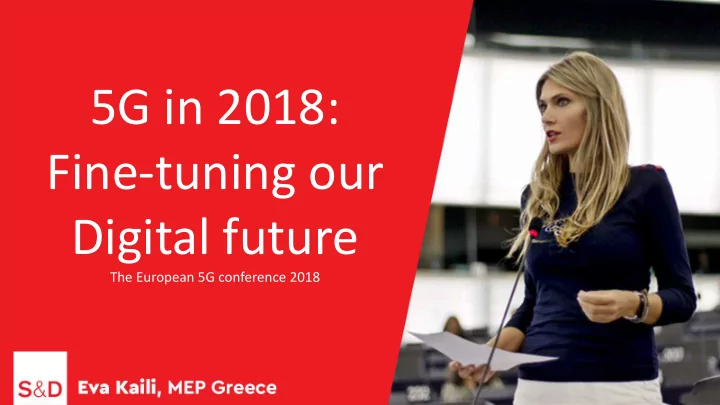

5G in 2018: Fine-tuning our Digital future The European 5G conference 2018
The backbone of digital economy • AI, Internet of Things, Blockchain, e-commerce, cybersecurity have one thing in common: they rely on a good network; • With the recent abolishing of Geoblocking, we have achieved a major step against discrimination, but we need to ensure that the telecommunications sector will continue to allow us to reduce discrimination, to give opportunities to our citizens and to explore technologies like AI and IoT.
5G: Race to the top • Winter Olympic Games- world’s first broad-scale 5g network pilot project; • Reminder of the race to the top, that the EU is trying to win; • higher quality fixed and mobile broadband coverage is needed improve the everyday life of all citizens and help develop innovative applications we do not even imagine yet;
EU to the rescue • Commission connectivity targets aim to roll out ubiquitous, very high- capacity networks, and more specifically 5G, to boost Europe's global competitiveness and further the digitisation of European industry. All socioeconomic drivers should have access to internet download/upload • speeds of 1 gigabit of data per second; All European households should have access to connectivity offering a • download speed of at least 100 megabits per second ; All urban areas as well as major roads and railways should have uninterrupted • 5G coverage.
EU to the rescue • Commission presented an action plan on 5G focusing on the coordination in EU for commercial launches , the deployment of national 5G roadmaps , the coordination for the identification and allocation of spectrum bands for 5G and the development of common global 5G standards . • Legislative priorities are backed up by concrete action: 5G-Public Private Partnership project (5GPPP) under the umbrella of the Horizon 2020 research programme.
Challenges New connectivity targets for 2025 will be outdone by reality of user demand; To reach these targets we need to address these challenges: • Spectrum • Investment • Revenue allocation • Connectivity divide
Facing the challenges These challenges are not new. We faced them before and I hope that we have learned our lesson. To address them we need a holistic approach. Indicatively: • Legislative steps : With the Telecommunications code and ePrivacy in trilogue negotiations we are hoping to address several of the problems that impede innovation most notably the spectrum allocation. One day smart contracts based on Blockchain to manage spectrum licencing; • Investment: The European Fund for Strategic Investment has as a priority to give access to funds, especially in regions with poor performance, alleviating part of the burden that operators have to carry, but also can be of help in rural coverage;
Facing the challenges Coverage: Simplify procedures for financial instruments that the Commission has made available so as to support broadband development in rural areas. Further incentives as a tax cut could be employed in rare cases. Standardization: gain a competitive advantage by taking a leading role in the technology's definition and standardisation.
Conclusion Big revenues are expected from the gigabit economy. Fundamental to allow room for innovation and disruption . We need to create the conditions that will create success. We need to allow companies to innovate. If something follows the rules it is not innovative.
Recommend
More recommend